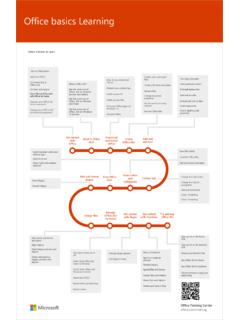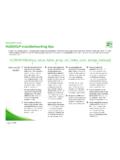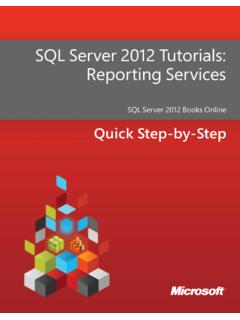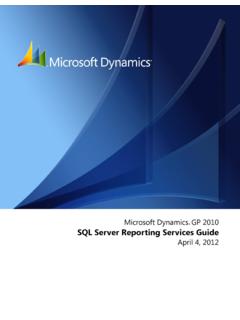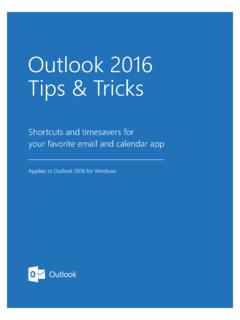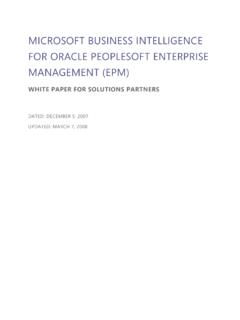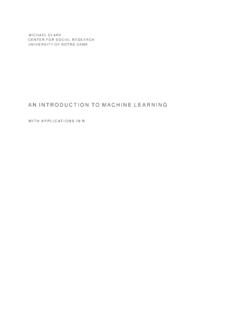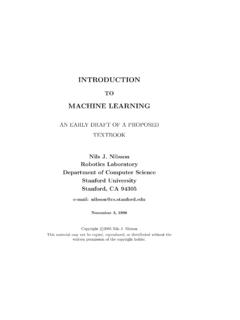Transcription of Introducing Azure Machine Learning - …
1 David Chappell Introducing Azure Machine Learning A GUIDE FOR TECHNICAL PROFESSIONALS Sponsored by Microsoft Corporation Copyright 2015 Chappell & Associates 2 Contents What is Machine Learning ? .. 3 The Machine Learning Process ..5 What Azure ML Provides ..7 A Closer Look at Azure 9 Preparing Data ..9 Running Experiments ..11 Machine Learning Algorithms ..12 Supervised and Unsupervised Learning ..13 Testing a Model ..13 Deploying and Using a Model ..14 Pricing ..16 Conclusion .. 17 About the Author .. 17 3 What is Machine Learning ? Data can hold secrets, especially if you have lots of it.
2 With lots of data about something, you can examine that data in intelligent ways to find patterns. And those patterns, which are typically too complex for you to detect yourself, can tell you how to solve a problem. This is exactly what Machine Learning does: It examines large amounts of data looking for patterns, then generates code that lets you recognize those patterns in new data. Your applications can use this generated code to make better predictions. In other words, Machine Learning can help you create smarter applications. For example, suppose you want to create software that can determine, with a high degree of accuracy, whether a credit card transaction is fraudulent.
3 What s the right approach for doing this? One option is to get a few smart people together in a room and think about it, then write code that implements whatever they come up with. This is probably the most common approach to creating software solutions today, and it certainly can work. But if there s data available about the problem you re trying to solve, you might instead use that data to figure out an effective solution. For example, suppose you re trying to find the best approach for detecting credit card fraud, and all you have to work with is the historical data shown in Figure 1. Figure 1: With just a small amount of data, it s hard to find accurate patterns.
4 The good thing about having so little data is that you might be able to find a pattern just by looking at it. The bad thing about having so little data is that the pattern you find is likely to be wrong. Given the data in Figure 1, for example, you might decide that anybody whose name starts with P is a fraudster, which probably isn t correct. With more data, your odds of finding a more accurate pattern get better, but finding that pattern will be more difficult. For instance, suppose you have the set of credit card transaction data shown in Figure 2 to work with. 4 Figure 2: More data can help in finding better patterns.
5 With this much data, it s immediately obvious that our first guess at a pattern everybody whose name starts with P is a crook can t be right. Look at the customer named Pali, for example. But if that simple guess was wrong, what s the right answer? In the data shown here, customers in their 20s seem to have a high fraud rate, but then look at customer Smith he doesn t fit this pattern. Or could it be customers whose credit card was issued in the USA but used in Russia? That also looks suspicious. But no, look at the customer named Jones; she doesn t fit this pattern. Okay, then maybe a combination of things can be used to detect fraud.
6 How about customers whose card was issued in the USA, used in Russia, and are in their 20s? Wrong again the cardholder named Norse violates this rule. The truth is that the pattern the data supports is this: A transaction is fraudulent if the cardholder is in his 20s, the card was issued in the USA and used in Russia, and the amount is more than $1,000. With some time, you probably would have figured this out, since the data you have to work with isn t very large. But suppose you have not just ten records to work with, as in Figure 2, but ten million. And suppose that for each record, you have not just the six columns of data shown in Figure 2, but 60 columns.
7 There s probably a useful pattern hidden in that data for determining which transactions are likely to be fraudulent, but you ll never figure it out by manually looking at the data there s too much of it. Instead, you have to use statistical techniques, approaches that are designed for finding patterns in large amounts of data. And you ll need to apply those techniques to the data by running them on a computer. This is exactly what the Machine Learning process does: It applies statistical techniques to large amounts of data, looking for the best pattern to solve your problem. It then generates an implementation code that can recognize that pattern.
8 This generated code is referred to as a model, and it can be called by applications that need to solve this problem. With fraud detection, for example, the calling application must provide the right information about a transaction, such as age, amount, where the card was issued, and where it s being used. The model created through Machine Learning then returns an indication of whether this transaction is likely to be fraudulent. 5 And while fraud detection is a good example, Machine Learning is applicable to much more than this. This technology can be used to predict an organization s future revenues, determine whether a mobile phone customer is likely to switch to another vendor, decide when a jet engine needs maintenance, recommend movies for customers, or anything else where lots of historical data is available.
9 (Because Machine Learning helps predict the future, it s often included in the broader category of predictive analytics.) All that s needed is the data, Machine Learning software to learn from that data, and people who know how to use that software. Azure Machine Learning ( Azure ML) is a cloud service that helps people execute the Machine Learning process. As its name suggests, it runs on Microsoft Azure , a public cloud platform. Because of this, Azure ML can work with very large amounts of data and be accessed from anywhere in the world. Using it requires just a web browser and an internet connection.
10 Still, understanding what this technology does requires a deeper look at how Machine Learning really works. The next section gives an overview of the process. The Machine Learning Process Whether an organization uses Azure ML or another approach, the basic process of Machine Learning is much the same. Figure 3 shows how it typically looks. Figure 3: The Machine Learning process starts with raw data and ends up with a model derived from that data. As the figure shows, Machine Learning starts with data the more you have, the better your results are likely to be. Because we live in the big data era, Machine Learning has become much more popular in the last few years.
